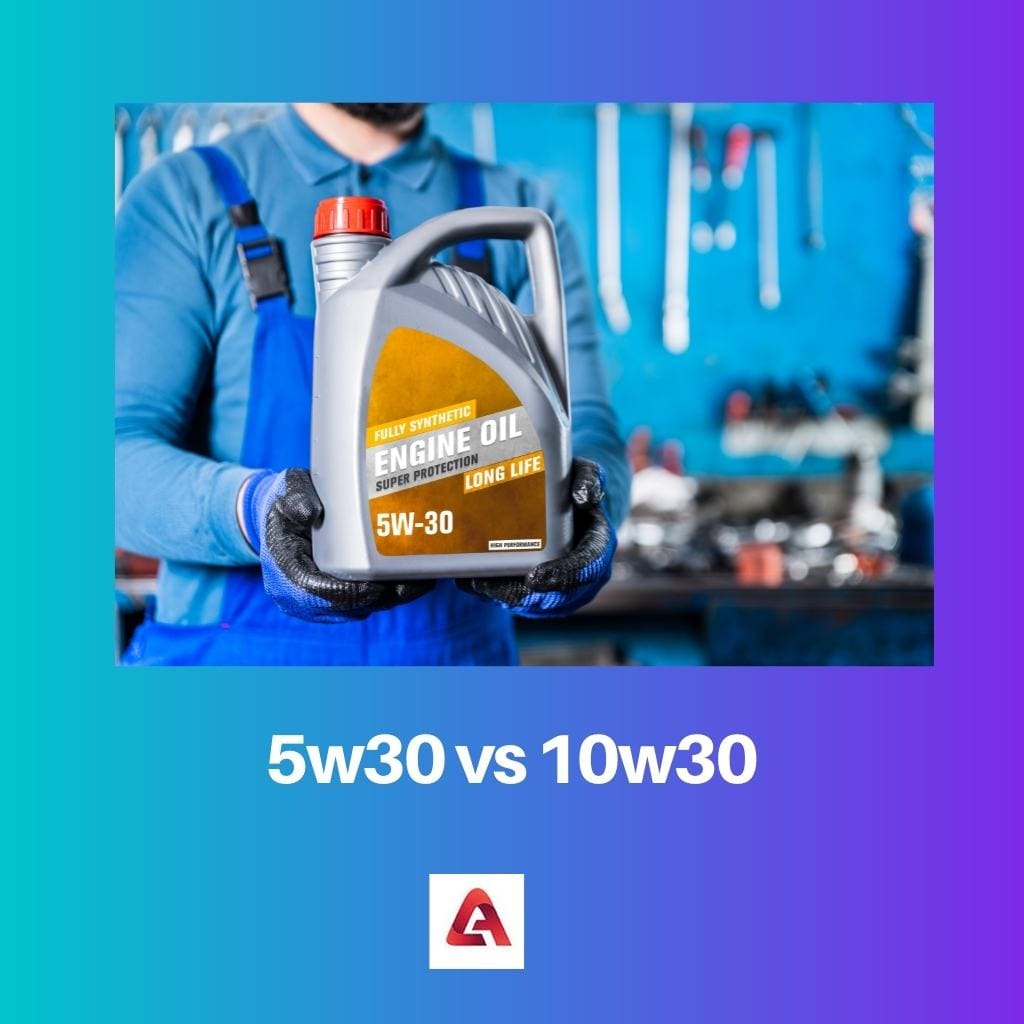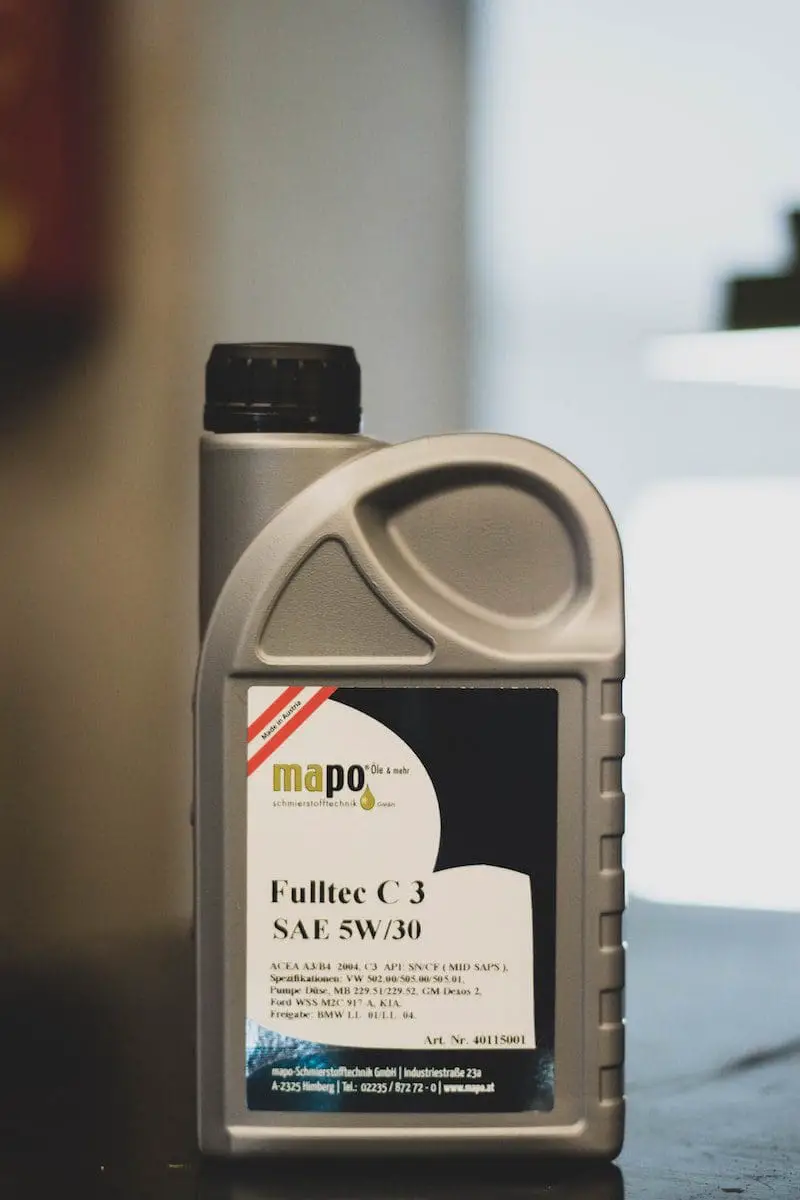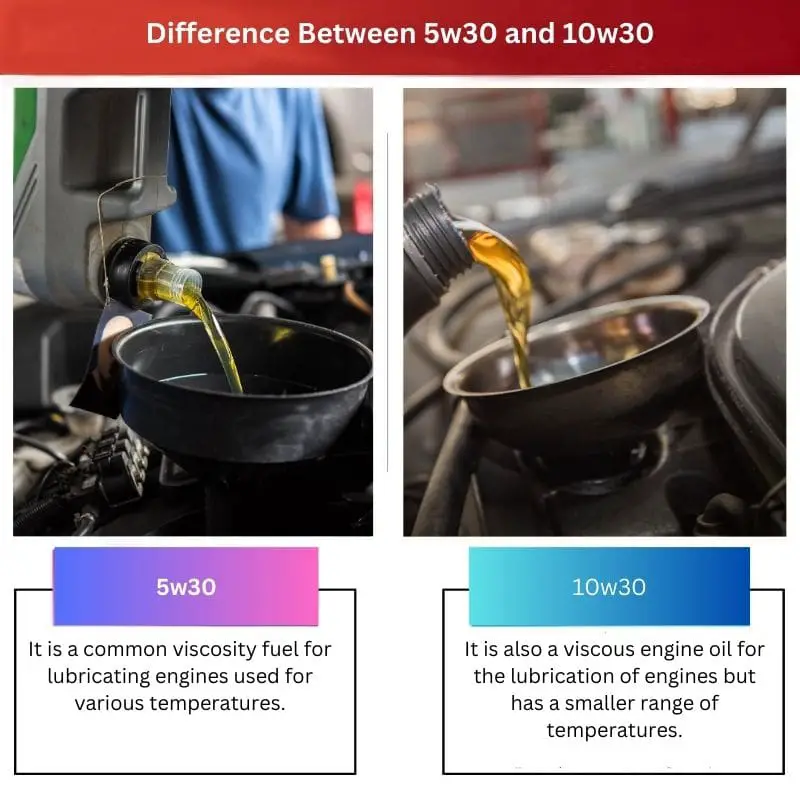5W30 and 10W30 are both common motor oil viscosities, with the numbers representing their viscosity at low and high temperatures. 5W30 flows more easily at cold temperatures, providing better cold-start protection, while 10W30 maintains viscosity better at high temperatures, offering improved engine protection under heat stress.
Key Takeaways
- Viscosity: 5w30 has a lower viscosity than 10w30, which flows more smoothly and provides better fuel economy.
- Temperature: 5w30 is recommended for colder temperatures as it has a lower cold cranking rating, while 10w30 is preferred for hotter weather.
- Compatibility: Both types of motor oil are compatible with most modern vehicles, but 10w30 is better suited for older engines with higher mileage.
5w30 vs 10w30
The difference between 5w30 and 10w30 is that 5w30 is less viscous and more efficient than 10w30 because the fuel is thinner and can reach the difficult part of the engine.

5w30 is a viscosity engine oil that is used for engine lubrication. The number 5 represents the level of viscosity of the oil, with 1 being the lowest viscosity and, therefore, better efficiency. They have low viscosity and can cover a large range of temperatures for various vehicles.
10w30 is also a viscosity engine oil for engine lubrication that is approved and named by SEA. The number 10, again, indicates viscosity level, so it is more viscous than 5w30. It is a thicker fuel that serves through a smaller range of temperatures.
Comparison Table
| Feature | 5w30 | 10w30 |
|---|---|---|
| Viscosity Rating | 5w-30 | 10w-30 |
| Cold Start Viscosity (W) | 5w (thinner at low temperatures) | 10w (thinner at low temperatures) |
| Operating Temperature Viscosity (30) | 30 (same viscosity at operating temperature) | 30 (same viscosity at operating temperature) |
| Cold Weather Performance | Better due to thinner oil at low temperatures, allowing easier flow and quicker engine lubrication. | Adequate for moderate cold weather, but may cause slightly slower oil flow and longer engine warmup time in very cold climates. |
| Fuel Efficiency | Potentially better due to lower viscosity at operating temperature, reducing friction and improving fuel economy. | Slightly less efficient compared to 5w30, as thicker oil can cause more friction. |
| Hot Weather Performance | Adequate for most climates. | Adequate for most climates. |
| Recommended Use | Primarily for modern engines designed for lower viscosity oils. May also be suitable for older engines in moderate climates. | Suitable for various engine types, including older engines and those operating in warmer climates. |
| Availability | Widely available | Widely available |
What is 5w30?
5W30 motor oil is a widely used lubricant in the automotive industry, known for its versatility and performance across a range of operating conditions. The designation “5W30” refers to its viscosity rating, which is determined by its flow characteristics at both low and high temperatures.
Characteristics of 5W30 Motor Oil
1. Viscosity at Low Temperatures (5W): At low temperatures, the “5” in 5W30 indicates its low viscosity. This means that the oil flows more easily when the engine is cold, providing rapid lubrication to critical engine components during start-up. This improves cold-start performance, reduces wear on engine parts, and enhances fuel efficiency.
2. Viscosity at High Temperatures (30): The “30” in 5W30 signifies its viscosity at high temperatures. Despite being thinner at low temperatures, 5W30 maintains a stable viscosity even at elevated engine temperatures. This ensures proper lubrication and protection of engine parts under operating conditions where temperatures can rise significantly.
Applications and Recommendations
5W30 motor oil is commonly recommended for a wide range of vehicles, including modern gasoline engines and some diesel engines. It is particularly suitable for regions with variable climates, where temperature fluctuations are common.

What is 10w30?
10W30 motor oil is a popular lubricant choice for various vehicles, providing a balance of viscosity characteristics suitable for different operating conditions. Understanding its composition and performance attributes is crucial for optimal engine maintenance.
Characteristics of 10W30 Motor Oil
1. Viscosity at Low Temperatures (10W): The “10” in 10W30 denotes its viscosity rating at low temperatures. Despite being slightly thicker than oils with lower W ratings, 10W30 still flows relatively well at cold starts, ensuring rapid lubrication to critical engine components. This feature enhances engine protection during initial start-up and contributes to smoother operation.
2. Viscosity at High Temperatures (30): At high temperatures, 10W30 maintains a stable viscosity, represented by the “30” designation. This viscosity level ensures adequate lubrication and protection for engine components operating under elevated temperatures. The oil’s viscosity prevents it from thinning excessively, providing essential lubrication even in demanding conditions.
Applications and Recommendations
10W30 motor oil is suitable for a wide range of vehicles, including gasoline engines in cars, trucks, and SUVs. It is recommended for engines subjected to moderate to high operating temperatures. However, it’s essential to refer to the vehicle manufacturer’s recommendations to ensure compatibility with your engine type and driving conditions.
Main Differences Between 5w30 and 10w30
- Viscosity at Low Temperatures:
- 5W30 is thinner than 10W30 at low temperatures, providing better cold-start performance.
- 10W30 is slightly thicker at low temperatures, though still offering adequate flow for lubrication during start-up.
- Viscosity at High Temperatures:
- 5W30 maintains its viscosity better at high temperatures compared to 10W30.
- 10W30 remains relatively stable under high temperatures but is thicker than 5W30.
- Application and Climate Suitability:
- 5W30 is recommended for regions with colder climates or for engines that require enhanced cold-start protection.
- 10W30 may be more suitable for warmer climates or engines that operate under moderate to high temperatures regularly.
- Engine Compatibility:
- Both oils are commonly used in modern gasoline engines, but specific recommendations may vary based on the manufacturer’s guidelines.
- Consult the vehicle owner’s manual or manufacturer recommendations to determine the best oil viscosity for your engine.




